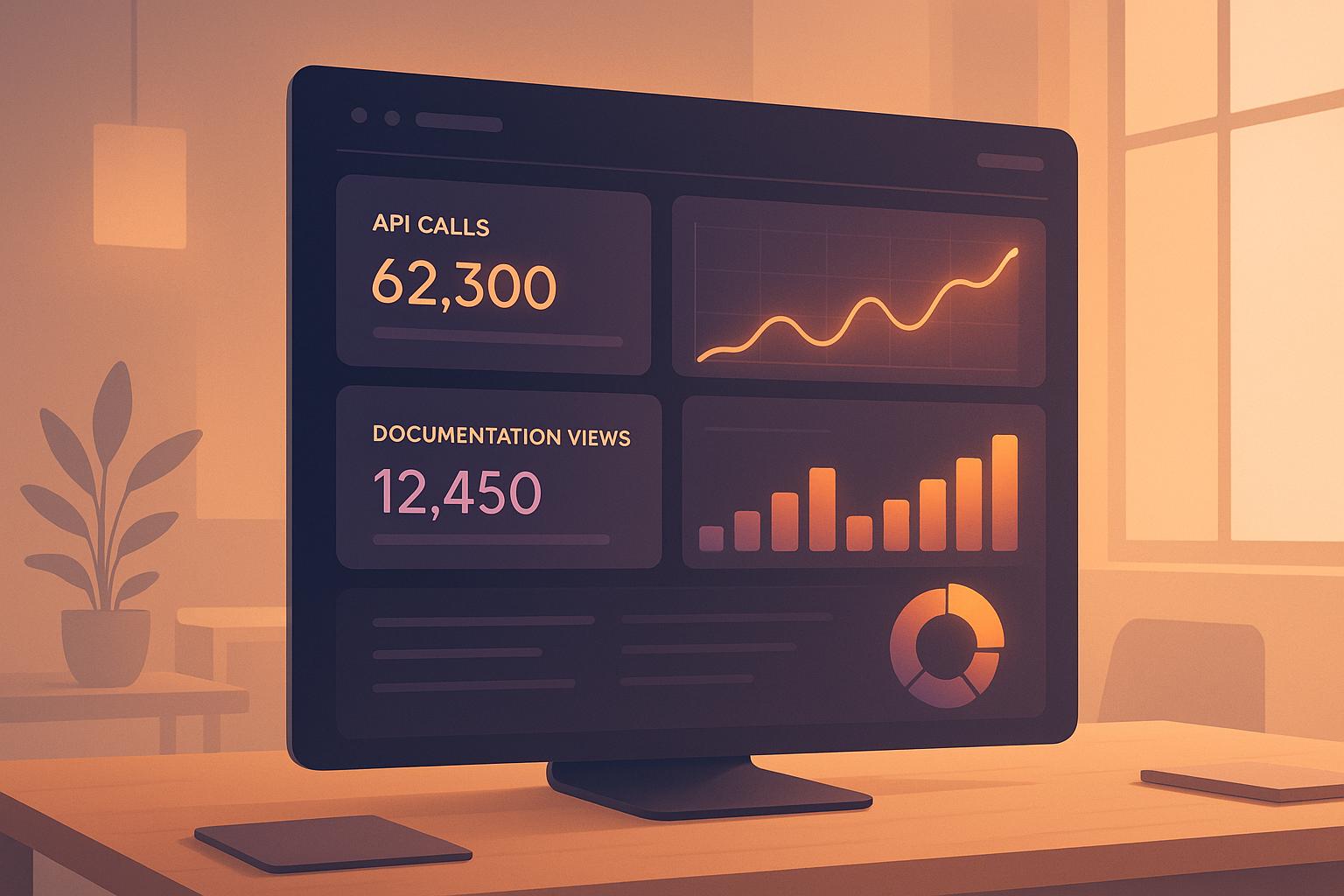


Track developer engagement through key metrics like API calls and documentation views to refine your marketing strategies and improve ROI.
Want to know if your developer marketing efforts are working? Start by tracking the right metrics. Developers engage differently than other audiences, so measuring success requires focusing on their unique behaviors. Here's the key takeaway:
Developer marketing metrics should align with how developers interact with your content, tools, and product. This means tracking actions like API calls, documentation views, SDK downloads, and sandbox sign-ups - not just traditional metrics like clicks or form submissions.
Key Metrics to Focus On:
- Impressions & Reach: Visibility on platforms like GitHub or Stack Overflow.
- Engagement Rate: Time spent on technical content, code downloads, or API usage.
- Conversion Rate: Steps like signing up for API keys or integrating your product.
- Retention Metrics: Active usage over time, such as monthly API calls or feature adoption.
- ROI & Cost Metrics: Developer acquisition cost (CAC) and long-term value (LTV).
These metrics provide insight into each stage of the developer journey - from awareness to advocacy. They also help identify bottlenecks, refine campaigns, and justify budgets.
#2 [Solo] Attribution and incrementality in developer marketing
Core Developer Marketing Metrics to Track
To run a successful developer-focused campaign, you need to measure the right metrics - ones that reflect how developers interact with your technical content. Here’s a breakdown of the key indicators to keep an eye on.
Impressions and Reach
Impressions count how often your content appears in front of developers, while reach measures the unique number of developers who see it. Together, these metrics give you an idea of your visibility within the developer community.
In developer marketing, impressions often need to be repeated before a developer takes action. Meanwhile, reach becomes especially valuable when targeting niche groups. For example, connecting with a small, specialized audience of engineers with unique skills can be far more impactful than casting a wide net. To get a full picture, track impressions across developer-specific platforms like GitHub, Stack Overflow, technical blogs, and forums - not just on general social media.
Engagement Rate
Engagement rate tells you how actively developers interact with your content, beyond just viewing it. For this audience, meaningful engagement includes actions like clicking through to detailed documentation, spending time on technical pages, downloading code samples, or testing interactive tools.
Surface-level metrics like likes and shares don’t hold as much weight here. Instead, focus on indicators of deeper interaction. For instance, a developer who spends time exploring your API documentation is showing far more interest than someone who simply clicks "like" on a tweet. Metrics like documentation views, SDK downloads, sandbox account signups, and GitHub repository interactions provide a clearer picture of how engaged developers are with your tools. Strong engagement often translates into measurable conversions.
Conversion Rate
Conversion rate tracks the percentage of developers who take a desired action after engaging with your campaigns. These conversions often involve multiple technical steps.
Examples of developer-specific conversions include signing up for API keys, downloading SDKs, creating sandbox accounts, or integrating your service into their projects. By analyzing conversion rates at different stages - like moving from documentation views to project integration - you can pinpoint where developers drop off and where your campaigns are most effective.
Additionally, technical milestones matter just as much as traditional business goals. For instance, a developer successfully making their first API call is a major step that signals long-term potential, even if it doesn’t immediately result in revenue. Once developers convert, tracking their retention helps measure ongoing engagement.
Retention Metrics
Retention metrics show whether developers continue to use and engage with your product over time. Unlike consumer products, developer tools often see gradual adoption, with loyalty growing as integrations deepen.
Metrics like daily, weekly, and monthly active developers help set realistic expectations. A developer might not use your API daily but could still be highly valuable if they rely on it for critical processes periodically. Cohort analysis can also uncover trends, such as stronger retention among early adopters. Tracking retention by acquisition channel is particularly useful, as developers brought in through technical content often show higher long-term engagement.
ROI and Cost Metrics
Finally, financial metrics ensure your campaigns aren’t just engaging but also cost-effective. ROI and cost metrics help refine your budget and strategy.
Developer acquisition costs (CAC) tend to be higher due to longer evaluation periods. Instead of focusing on short-term snapshots, evaluate CAC over extended timelines for a more accurate picture of efficiency. Cost Per Lead (CPL) can also vary significantly depending on the channel. For instance, sponsorships on niche technical blogs may deliver lower CPL compared to large-scale conferences. Tracking CPL by channel helps you identify the most cost-effective ways to reach and convert developers.
When calculating Lifetime Value (LTV) for developers, consider both direct usage and their broader influence. A single developer could inspire team-wide or even community-wide adoption of your product. Keep an eye on metrics like Revenue Per Developer (RPD) to understand which channels bring in the most valuable users.
Tools for Tracking and Interpreting Metrics
Effective tools like Google Analytics 4 (GA4) make it easier to track developer engagement with precision. GA4 is a must-have for monitoring website and app activity, especially in developer-focused marketing campaigns. It provides a solid foundation for capturing all the critical interactions developers have with your platform.
Using Google Analytics for Developer Campaigns
To get started with GA4, you’ll need to:
- Create an Analytics account.
- Set up a GA4 property.
- Add data streams for your website or app using gtag.js, your CMS, or Google Tag Manager.
With enhanced measurement enabled, GA4 automatically tracks important events like page views, scrolls, outbound clicks, site searches, video interactions, and file downloads. This feature helps you cover the basics without extra configuration.
For developer-specific tracking, you can implement custom events to capture actions not included in the default setup. Additionally, the Measurement Protocol allows you to send server-to-server or offline events, such as backend API calls or SDK interactions. GA4 also supports conversion tracking tailored to developer engagement, helping you measure key actions that matter most in your campaigns.
sbb-itb-e54ba74
Using Metrics to Improve Developer Campaigns
Breaking down your metrics by developer traits can help you fine-tune campaigns and craft messaging that resonates with specific audiences.
Finding Bottlenecks and Opportunities
Diving into your metrics can reveal where developers lose interest in your funnel and where your campaigns shine. For instance, if you notice many developers are reading your documentation but not downloading your SDKs, it might signal that your documentation lacks clear next steps or that your SDK onboarding process feels too complicated.
You can also compare how different channels perform. For example, if technical blog referrals bring in developers who stick around longer compared to social media referrals, it might be worth shifting more resources toward building partnerships with technical content creators. Similarly, tracking which types of content bring in the most qualified leads can guide your overall content strategy.
Segmenting Metrics for Better Insights
Segmenting your data by developer attributes - like their preferred programming language - can uncover important trends. For instance, JavaScript developers might engage differently than those working with Python or Go. Experience level is another key factor; junior developers may look for beginner-friendly resources, while senior developers might prioritize in-depth technical content. Geographic data can highlight regional preferences, and segmenting by company size or industry can sharpen your targeting even further.
You can make segmentation even more precise by asking developers to self-identify through lead forms. Questions like “What’s your primary programming language?” or “What’s your team size?” can provide actionable insights for better targeting.
Adjusting Campaign Strategies
Use the insights from segmentation to fine-tune your campaigns. For example, create content that appeals to specific groups: advanced features for seasoned developers and beginner guides for those just starting out.
Make sure to revisit and refine your segmentation strategies regularly. Keeping your personas and strategies aligned with the latest data ensures your campaigns stay relevant and effective.
Conclusion
Key Points Recap
Achieving success in developer marketing boils down to tracking the right metrics and acting on the insights they provide. Key indicators like impressions, engagement rates, conversion rates, retention, and ROI offer a comprehensive view of how your campaigns perform at each stage of the developer journey. The real magic happens when you dig deeper into these numbers to spot bottlenecks and identify opportunities. For instance, you might notice that readers of your documentation aren't progressing to SDK downloads, or that technical blog referrals bring in more qualified leads compared to social media. These insights lay the groundwork for making smarter, data-driven decisions.
Segmentation transforms raw data into actionable insights. By breaking down metrics based on factors like programming language, developer experience, company size, or geographic location, you can uncover trends that broad averages tend to obscure. A JavaScript developer has different expectations than a Go developer, and your campaigns should cater to these distinct needs.
Keep your tracking tools straightforward and easy to use. Whether you rely on Google Analytics, Mixpanel, or custom dashboards, choose platforms that match your team's technical expertise and reporting requirements.
Beyond just setting up tracking, continuous refinement is key. Developer marketing metrics are not static - they require regular updates and adjustments to stay relevant. As the developer ecosystem changes and your audience grows, your measurement strategies should adapt too. The most successful companies treat metrics as an ongoing feedback loop, not just a quarterly task.
Your metrics tell a story about your developer audience. Metrics like impressions, engagement, conversions, retention, and ROI guide you through each step of the developer journey. Pay attention to what the numbers reveal and use them to create campaigns that resonate with developers.
FAQs
Why aren’t traditional metrics like clicks and form submissions enough for measuring developer marketing success?
Traditional metrics like clicks and form submissions don’t quite capture how developers interact with content. Developers value hands-on engagement - things like contributing to code repositories, downloading SDKs, or experimenting with APIs - far more than superficial actions like clicking on ads or opening emails.
What’s more, these traditional metrics don’t account for the depth and quality of interaction, which are key to gauging how well your campaign connects with developers. By focusing on metrics that reflect their actual behaviors and interests, you’ll get a clearer picture of how effective your marketing efforts really are.
How does segmenting metrics by developer attributes improve marketing campaigns?
Segmenting metrics based on developer attributes lets you craft targeted campaigns that speak directly to specific groups of developers. By examining factors like their expertise, favorite tools, or the industries they work in, you can fine-tune your messaging to address their distinct preferences, ultimately driving better engagement and satisfaction.
This strategy also makes resource allocation smarter. By pinpointing which developer segments bring the most value, you gain a clearer understanding of their behavior. This clarity allows you to refine your approach, improve ROI, minimize churn, and strengthen your relationship with your audience.
What are some examples of custom events you can track in Google Analytics 4 for developer-focused activities?
In Google Analytics 4, you can set up custom events specifically designed to track developer-related actions. These events help you gain deeper insights into engagement and user behavior. Here are some examples:
- code_deployed: Tracks when a developer completes and deploys new code.
- bug_reported: Logs instances where users submit bug reports.
- feature_request_submitted: Monitors when users propose new feature ideas.
- api_call_made: Measures API usage and developer interactions.
- error_occurred: Captures occurrences of errors during processes.
- user_feedback_submitted: Records feedback or reviews provided by developers.
By analyzing these events, you can better understand how developers engage with your platform. This information can guide you in refining your marketing efforts and enhancing the overall user experience.






